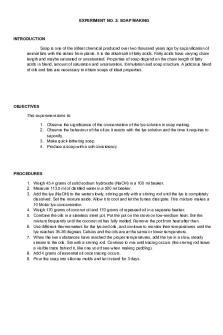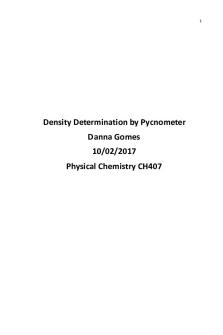NMR Laboratory Report PDF

| Title | NMR Laboratory Report |
|---|---|
| Author | Sophie Maghlakelidze |
| Course | A Physical Chemistry |
| Institution | San Diego State University |
| Pages | 17 |
| File Size | 677.8 KB |
| File Type | |
| Total Downloads | 25 |
| Total Views | 147 |
Summary
Report for the NMR lab...
Description
Sofiko Maglakelidze
NMR Determination of Keto-Enol Equilibrium constant 16.02.2021 Chem 417-G2
Introduction In this experiment, an NMR machine will be used to determine the approximate concentration ratio of the enol and keto forms of a tautomer in a solution. Also,we will determine how different environments affect tautomerization equilibrium constant. Experimental Methods: Detailed experimental procedure used for this experiment is given in the Chem 417 laboratory manual, the experiment #1 “NMR determination of Keto-Enol Equilibrium Constant”. Each student prepared 4 tubes with sample solutions and two NMR tubes with solvent only, one with deuterated chloroform and one with the methanol mixture. The solvents will be spiked with TMS. In total each student had to analyze 6 samples. The information about these solutions is given in the appendix part Table1. The machine used for this experiment was the Bruker Ascend 400 MHz NMR spectrometer. Results: 1 H NMR spectra was obtained for all 4 samples. The peaks were integrated and we assigned them to the corresponding hydrogen atom in the molecule. The NMR spectras for the samples are given in the appendix part in figures 1-4. The peak shifts, the integrated values, and assignments for the 4 samples are listed in tables 2-5. Using charts for proton chemical shifts for 1 H NMR and the complete worksheet we prepared beforehand (see the worksheet part of the report) we were able to assign peaks to corresponding protons in the structure. Next we compared the theoretical (present in the worksheet) and experimental ratios of peaks of different protons. These values are presented in the Table 6 in the Appendix section. For the next step we calculated the Keq for each solution and estimated the uncertainty; as well as %enol for each solution, and GO for the keto-enol tautomerization. For these calculations following formulas were used: Keq=[enol]/[keto] In order to calculate the uncertainty we used an alternate way to calculate Keq , such as taking the ratio of all of the integrated peaks instead of just the methyl proton, and then those two values were averaged and the difference between average value and the value of keq turned out to be uncertainty. % enol = 100 x [enol]/([enol]+[keto] = Keq/(Keq+1) ∆G = -RTlnK K eq =e -ΔG/RT For these calculation temperature was 20 o C=293K All the results of these calculations are given in an Appendix section Table 7.
Discussion: The overall experiment was successful. The small differences between theoretical and experimental values can be conditioned by systematic and experimental errors. As we can see from the results section of this report, the equilibrium constant for acetylacetone is greatest in the gas phase, then in CCl4, then in CDCl3 and lastly the smallest is in methanol. Meaning it is favouring enol form over the keto form. This can be explained by the differences in the dipole moment of the solvents: 1.0 D for CCl3D, 1.7 D for methanol, and 0 D for CCl4. As we can see, methanol has the largest dipole moment, meaning it is shielding and preventing the two oxygen atoms from interacting with the hydrogen atom and thus the keto form would be favored. CDCl3 and CCl4 would have even smaller interactions respectively. Finally, the acetylacetone molecules in the gas phase do not interact with anything, so the enol form is more favored than the keto form. Contradictorily to acetylacetone, ethyl acetoacetate favors the keto form both in methanol and in Chloroform. One of the possible explanations for this is that for ethyl acetoacetate, the keto form is sterically more favorable than the enol form.
Appendix: FIgure 1 Sample 1 Acetylacetone in CDCl3
Figure 2 Sample 2 Acetylacetone in methanol
Figure 3 Sample 3 Ethyl Acetoacetate in CDCl3
Figure 4 Sample 4 Ethyl acetoacetate in methanol
Table 1 The sample compositions. Sample
Acetylacetone
Ethyl Acetoacetate
Deuterated Chloroform
Methanol Mixture
1
0.002 mole
-
0.008 mole
-
2
0.003 mole
-
-
0.012 mole
3
-
0.002 mole
0.008 mole
-
4
-
0.003 mole
-
0.012 mole
Table 2 Sample 1 Chemical Shift ppm
Multiplicity
Relative Peak Area
Peak Assignment
15.45
Singlet
13.62
OH (enol)
5.45
Singlet
16.70
=CH- (enol)
3.50
Singlet
6.13
CH2 (keto)
2.25
Singlet
19.83
CH3 (keto)
2.00
Singlet
100.00
CH3 (enol)
Chemical Shift ppm
Multiplicity
Relative Peak Area
Peak Assignment
5.6
Singlet
17.95
=CH- (enol)
3.65
Singlet
12.16
CH2 (keto)
2.20
Singlet
35.23
CH3 (keto)
2.00
Singlet
100.00
CH3 (enol)
Chemical Shift ppm
Multiplicity
Relative Peak Area
Peak Assignment
12.1
Singlet
2.87
OH (enol)
5
Singlet
2.84
=CH- (enol)
4.2
Quartet
73.68
O-CH2 (both)
Table 3 Sample 2
Table 4 Sample 3
3.48
Singlet
65.39
CH2 (keto)
2.25
Singlet
100.00
CH3 (keto)
1.94
Singlet
8.81
CH3 (enol)
1.27
Triplet
115.46
O-CH2CH3 (both)
Chemical Shift ppm
Multiplicity
Relative Peak Area
Peak Assignment
12.1
Singlet
1.67
OH (enol)
5.00
Singlet
2.18
=CH- (enol)
4.15
Quartet
78.77
O-CH2 (both)
3.52
Singlet
68.93
CH2 (keto)
2.21
Singlet
100.00
CH3 (keto)
2.14
Singlet
8.93
CH3 (enol)
1.25
Triplet
120.50
O-CH2CH3 (both)
Table 5 Sample 4
Table 6 The comparison of theoretical and experimental ratios of protons for all samples Sample
Form
Ratio
Theoretical
Experimental
1
Keto
CH3/CH2
3/1
3.23/1
Enol
CH3/CH
6/1
5.99/1
Keto
CH3/CH2
3/1
2.90/1
Enol
CH3/CH
6/1
5.57/1
Keto
CH3/CH2
1.5/1
1.53/1
Enol
CH3/CH
3/1
3.10/1
Keto
CH3/CH2
1.5/1
1.45/1
Enol
CH3/CH
3/1
4.09/1
2
3
4
Table 7 % enol
Keq
ΔGo (kJ/mol)
Acetylacetone in CDCl3
83.45
5.04±0.27
-3.94
Acetylacetone in methanol
73.95
2.84±2.49
-2.54
Ethylacetoacetate in CDCl3
8.10
0.088±0.0088
11.5
Ethylacetoacetate in methanol
8.20
0.089±0.066
5.90
Acetylacetone in the gas phase
97.61
40.91
-9.2 ± 2.1
Ethylacetoacetate in the gas phase
54.13
1.18
-0.4 ± 2.5
Acetylacetone in CCl4
92.68
12.66
-6.293 ± 0.079
References: ● Shoemaker, D. Pl; Garland, C. W.; Nibler, J. W., Experiments in Physical Chemistry, 5th edition (McGraw-Hill, NY, 1989) Exp. 44. ● Atkins, P.; de Paula, J. Physical Chemistry, 10th edition (Freeman, NY, 2014), Chap. 14. ● Cooksy, A. Physical Chemistry: Quantum Chemistry and Molecular Interactions, (Pearson, Boston, 2014), Section 5.5.
Worksheet 1. Methanol a) Why is the OH peak a quartet and the CH3 peak a doublet in the spectrum of 10% methanol in CCl4 (Figure 1, page 9)? The proton from OH has three neighbouring protons from CH3 resulting in multiplicity- quartet. While proton from CH3 has only one neighbouring proton- OH resulting in doublet. In general there should not be any splitting but as CCl4 does not contain any H and and alcohol is very diluted there is no rapid exchange of protons thus the results are splitting. In the question d we explain the other example of the same alcohol. b) What is the predicted relative peak area of the two peaks? Does the observed value agree with this (the areas are given under the x axis in the figure)? Observed values are: 1:3. The predicted values should be 1 and 3 as the peak area corresponds to the number protons responsible for the peak. As our substance is methanol we only have one OH and one CH3 group. c) Predict the chemical shift of the methyl protons using Macomber’s tables (handout in class). Does the value agree with that given in Figures 1 and 2? By using the following formula: (XCH2Y) = (CH4) + (X) + (Y) and Macomber’s table we can calculated chemical shift for methyl protons: (CH3X)=(CH4)+(OH)=0.23ppm+2.97ppm=3.2ppm Which almost exactly corresponds to the actual value we got on the Figure 1 ad 2. d) Why are there no peak splittings in the spectrum of methanol containing only a trace of H2O (figure 2)? The H on oxygen rapidly exchanges with other such Hs, so lots of different H s will have spent a little time on a particular O. So those methyl protons "feel" a magnetic field perturbed, not by either one α or one β spin sitting on the O, but by many neighboring spins. The result is no net effect on the methyl Hs' NMR signal. The same is true for the signal of the hydroxyl H, each one of these Hs visits hundreds of methanol molecules in the time required for the NMR transition, so each one feels the cumulative effects of many different methyl H spin combos, thus the splitting is "averaged out” and the OH appears as a singlet.
2. Acetone a) Predict the chemical shift of the methyl protons of acetone using Macomber’s tables (show your work). The spectrum for pure acetone consists of a single peak located at = 2.09. Does your prediction agree with this? In the acetone molecule CH3 groups are symmetrical and their ppm is 0.23. The C(double-bond)O group equals 1.87. Thus the theoretical chemical shift will be equal to 0.23+1.87=2.1 for both methyl groups. This value is close to the observed value (2.09).
b) Explain the observed multiplicity (singlet). The only protons we have in this compound are from symmetrical methyl groups which are identical to each other. They have no other neighbouring protons, thus they will generate only one peak with no splitting.
3. Keto form of acetylacetone Predict the chemical shifts, relative areas, and multiplicities of the protons in the keto form of acetylacetone (show your work). Write the values in the table. For the relative area, set the area of the smallest peak equal to one, and calculate the areas of the others relative to this. A proton group is a set of equivalent protons. Then sketch the spectrum. Draw each peak as a line so the drawing won’t be too messy. The height of the line should be proportional to the relative number of protons. Predicted chemical shift (CH3X)=CH3+C[(double-bond)O]R+δ(β)CH2 =0.23+1.87+0.01=2.11ppm (XCH2Y)=CH2+C[(double-bond)O]R+C[(double-bond)O]R+δ(β)CH3+δ(β)CH3=0.23+1.87+1. 87+0.01+0.01=3.99 ppm Relative areas for the peak created by CH3 group will be equal to 3. Relative area for the peak corresponding to CH2 will be equal to 1.Thus it will be 1:3. Multiplicities will be singlets for both peaks. Proton Group
Chemical shift/δ(ppm)
Multiplicity
Relative area
CH3
2.11
Singlet
3
CH2
3.99
Singlet
1
4. Enol form of acetylacetone a) The enol form of acetylacetone has two equivalent resonance forms – draw these
b) Predict the chemical shifts, relative areas, and multiplicities of the protons in the enol form of acetylacetone (excluding the OH proton); show your work. Write the values in the table. For the relative area, set the area of one of the proton groups equal to one, and calculate the areas of the others. Predicting chemical shifts:
(CH3a)=0.23+1.87+0.01=2.11ppm (CHb)=5.28+1.1-1.05-0.26=5.07ppm (using table Vinyl Hydrogen Chemical Shifts) (CH3c)=0.23+0.35+0.15+0.62=1.35ppm Relative areas for both CH3 groups will be equal to 3 and forCH group=1. Thus it will be 3:1:3 Multiplicities for all the three groups will be singlets. Proton Group
Chemical shift/δ(ppm)
Multiplicity
Relative area
aCH3
2.11
singlet
3
bCH
5.07
singlet
1
cCH3
1.35
singlet
3
CH3 Average
1.73
singlet
6
c) Sketch the spectrum of the averaged peaks.
5. Sketch the NMR spectrum of a solution which contains both the enol and keto forms of acetylacetone.
K and e refer to keto and enol forms respectively.
6. Keto form of ethyl acetoacetate Predict the chemical shifts, relative areas, and multiplicities of the protons in the keto form of ethyl acetoacetate (show your work). Write the values in the table. Predicting chemical shift using Macomber’s table:
a(CH3)=0.23+0.01+1.87=2.11 ppm b(CH2)=0.23+1.77+1.87+0.01=3.88 ppm c(CH2)=0.23+0.62+2.97+0.33=4.15 ppm d(CH3)=0.23+0.62+0.35=1.2 ppm Proton Group
Chemical shift/δ(ppm)
Multiplicity
Relative area
a CH3
2.11
Singlet
1.5
b CH2
3.88
Singlet
1
c CH2
4.15
Quartet
1
d CH3
1.20
Triplet
1.5
7. Enol forms of ethyl acetoacetate Draw both enol resonance forms of ethyl acetoacetate below. Are the two resonance forms equivalent? Explain.
Both structures contribute equally thus there is no difference in stability between them.
8. Enol form of ethyl acetoacetate Predict the chemical shifts, relative areas, and multiplicities of the protons in the enol form of ethyl acetoacetate that you think is the most stable (show your work). Enol forms of this molecule do not produce separate resonance because their conversion is a rapid exchange process. Thus they will generate one NMR spectra. For easier identification we will use one form of these resonances:
Predicting chemical shift: a(CH3)=0.23+0.35+1.37=1.95 ppm b(CH)=5.28-0.26-1.05+0.84=4.81 ppm c and d groups (CH2 and CH3) are not affected by the tautomerization thus they will have the same chemical shift as in keto form, 4.15 ppm and 1.2 ppm respectively .*we exclude the OH proton Proton Group
Chemical shift/δ(ppm)
Multiplicity
Relative area
a CH3
1.95
singlet
3
b CH
4.81
singlet
1
c CH2
4.15
quartet
2
d CH3
1.20
triplet
3
9. From the results obtained in #6 and #8 above, sketch the NMR spectrum of a solution which contains both the enol and keto forms of ethyl acetoacetate.
K and e refer to keto and enol forms respectively....
Similar Free PDFs
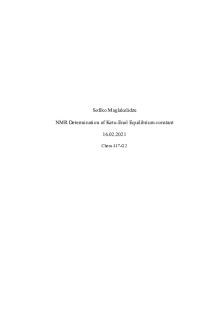
NMR Laboratory Report
- 17 Pages

Lab 1 - Laboratory Report
- 10 Pages

Laboratory+report+1-4
- 11 Pages

NMR - Riassunto corso NMR
- 3 Pages

Laboratory 11 - Lab Report
- 3 Pages

Laboratory report - aspirin
- 8 Pages

Laboratory Report 1 SKO3023
- 30 Pages

Laboratory Report Rubric
- 2 Pages
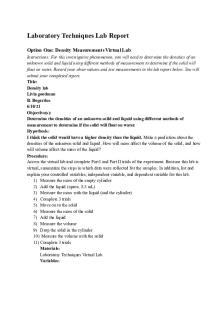
Laboratory Techniques Lab Report
- 4 Pages

LABORATORY REPORT EXPERIMENT 5
- 6 Pages

Laboratory report for BIO
- 4 Pages
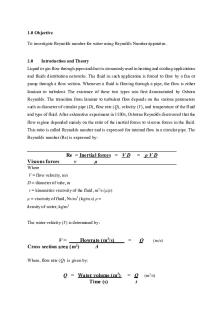
Reynold\'s Number Laboratory Report
- 11 Pages

Experiment 23 laboratory report
- 7 Pages

Taules NMR
- 3 Pages
Popular Institutions
- Tinajero National High School - Annex
- Politeknik Caltex Riau
- Yokohama City University
- SGT University
- University of Al-Qadisiyah
- Divine Word College of Vigan
- Techniek College Rotterdam
- Universidade de Santiago
- Universiti Teknologi MARA Cawangan Johor Kampus Pasir Gudang
- Poltekkes Kemenkes Yogyakarta
- Baguio City National High School
- Colegio san marcos
- preparatoria uno
- Centro de Bachillerato Tecnológico Industrial y de Servicios No. 107
- Dalian Maritime University
- Quang Trung Secondary School
- Colegio Tecnológico en Informática
- Corporación Regional de Educación Superior
- Grupo CEDVA
- Dar Al Uloom University
- Centro de Estudios Preuniversitarios de la Universidad Nacional de Ingeniería
- 上智大学
- Aakash International School, Nuna Majara
- San Felipe Neri Catholic School
- Kang Chiao International School - New Taipei City
- Misamis Occidental National High School
- Institución Educativa Escuela Normal Juan Ladrilleros
- Kolehiyo ng Pantukan
- Batanes State College
- Instituto Continental
- Sekolah Menengah Kejuruan Kesehatan Kaltara (Tarakan)
- Colegio de La Inmaculada Concepcion - Cebu
